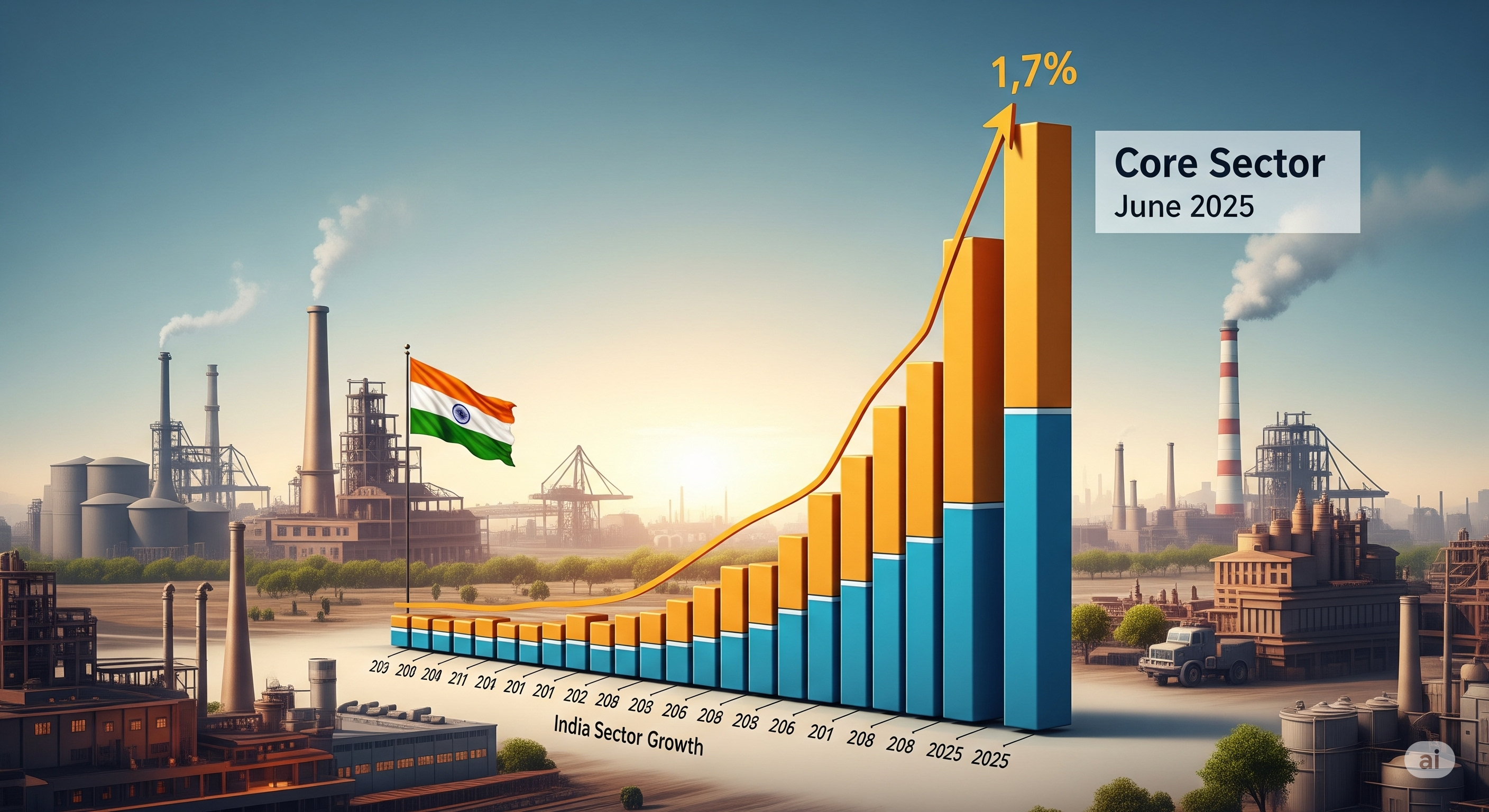-
Algos
-
Stocks
-
Trading
-
Strategies & Arbitrages
-
Mutual Funds

Ever wonder what the real engine of a country's economy looks like? It is not just the flashing numbers on the stock market; it is the foundational industries that produce the essential goods that build and power a nation.
This is what we call the "core sector." In India, this includes eight key industries: coal, crude oil, natural gas, refinery products, fertilizers, steel, cement, and electricity.
The latest data for June 2025 has just been released, and it is sending some mixed signals. Let's break down what the numbers are telling us in simple terms.
Before we get into the latest data, it is important to understand why we pay so much attention to these eight industries.
Think of them as the building blocks of the economy. They are crucial for infrastructure development, manufacturing, and energy production.
Because of their importance, these eight sectors have a combined weight of over 40 percent in the Index of Industrial Production (IIP). The IIP is like a monthly health check for the country's overall industrial and manufacturing activity.
So, when the core sector is doing well, it is a good sign for the broader economy. When it is struggling, it can be a cause for concern.
According to the latest data from the Ministry of Commerce and Industry, India’s core infrastructure sector grew to a three-month high of 1.7 percent in June.
The Good News: A Minor Rebound This is a slight improvement from the 1.2 percent growth seen in May. On the surface, a three-month high sounds like good news, and it shows a small sign of a rebound.
The Bad News: The Bigger Picture is Still Sluggish However, this is the third consecutive month that growth has been below the 2 percent mark. This indicates that the overall momentum in these foundational industries remains weak.
When we look at the performance for the entire first quarter of the financial year (April to June), the picture is even more concerning. The core sector output expanded by just 1.3 percent, a sharp fall from the much healthier 6.2 percent growth seen during the same period last year.
The overall growth number of 1.7 percent hides a very mixed performance among the eight industries. In fact, five of the eight sectors actually saw their output shrink in June.
The Bright Spots: Steel and Cement Hold Strong The clear winners this month were the steel and cement sectors. - Steel production grew by a robust 9.3 percent. - Cement output also saw strong growth at 9.2 percent.
This strong performance is largely thanks to the government's continued spending on big infrastructure projects like roads, bridges, and railways. This is what economists refer to as "government capex" (capital expenditure).
The Laggards: Coal and Electricity Under Pressure On the other end of the spectrum, some key sectors struggled. - Coal production saw the sharpest contraction, falling by 6.8 percent. This was partly due to a high base effect, meaning it is being compared to a very strong performance from the same month last year. - Electricity generation also contracted for the second month in a row, declining by 2.8 percent. Experts suggest that excess rainfall in the latter half of June likely impacted power generation and demand.
The Others: A Mixed and Muted Performance The remaining sectors showed a mixed but generally weak performance. - Petroleum Refinery Products was the only other sector to show positive growth, at 3.4 percent. - Crude Oil production fell by 1.2 percent. - Natural Gas output declined by 2.8 percent. - The contraction in Fertilizers narrowed, with output falling by 1.2 percent.
Economists and analysts have described the latest core sector numbers as "decidedly tepid," meaning they are lukewarm and lack any real strength.
Aditi Nayar, the chief economist at ICRA, pointed out that while the headline number improved slightly, the fact that five of the eight sectors contracted is a major concern.
Paras Jasrai, an associate director at India Ratings and Research, noted that the strong performance in steel and cement was a positive sign, likely driven by steady government spending.
The sluggish performance of the core sector is expected to have a direct impact on the broader economic data for June.
Economists believe that this will likely keep the overall IIP growth for the month at a very low level, estimated to be around 1.5 percent.
Looking ahead, the initial data for July also suggests that the weak trend may continue. This, combined with an unfavorable base effect from last year, could keep the core sector output growth at around 2 percent in July.
This subdued performance in the infrastructure sector could also weigh on the overall GDP growth for the first quarter of the financial year.
The latest core sector data paints a picture of an economy that is facing some headwinds. While government spending is providing a much-needed cushion, several key industries are struggling to find momentum.
The coming months will be crucial to see if this is a temporary slowdown or a sign of a more persistent weakness in the industrial sector. For businesses and investors, keeping a close eye on these high-frequency indicators is more important than ever.
For more in-depth economic analysis and market insights, you can follow us at TheAIBull.com.

NSDL's upcoming IPO is priced at a steep 22% discount to its grey market value. Find out why the company chose a lower price and what it means for you.

State Bank of India (SBI) has raised ₹25,000 crore through a QIP. Learn about the details of the share sale, LIC's investment, and what it means for the bank.

SEBI has issued a draft circular proposing significant changes to the categorisation of mutual fund schemes. Find out what this means for investors.

Discover why the Nifty fell below the key 25,000 mark and what investors are watching next as heavyweights like RIL and HDFC Bank prepare to report earnings.

Discover why weak Q1 earnings, FII outflows, and trade deal concerns are putting pressure on the Indian stock market.

SEBI is concerned about high volumes in short-term F&O contracts. Learn why the regulator may increase contract tenures and what it means for retail traders.
